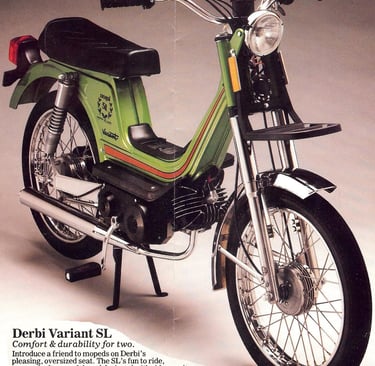Derbi: The Spanish Motorcycle Legacy
Article Summary Derbi, a Spanish motorcycle brand, was established in 1922 as a small bicycle workshop in the village of Mollet near Barcelona. The company shifted its focus towards motorized vehicles and unveiled its first real motorcycle, the Derbi 250, in 1950. Derbi found considerable success in motor racing, particularly in the 50cc and 125cc classes of Grand Prix motorcycle racing. Spain's motorcycle racing legend, Ángel Nieto, was a prominent figure in securing Derbi's first world championship win in the 50cc class in 1970. Derbi's racing success is crucial to understanding the brand's journey, technological innovations, and its place in motorcycle history.
MOPED CULTURE DERBI SPAIN 1970'STWO STROKE
11/5/20232 min read


Derbi: The Spanish Motorcycle Legacy
Origins and Early History
In the picturesque village of Mollet near Barcelona, Spain, a humble bicycle workshop in 1922 marked the birth of what would become a significant player in the motorcycle industry: Derbi. Founded by Simeó Rabasa i Singla, the workshop initially focused on bicycle repair and rentals. As fate would have it, this small workshop would soon become a manufacturing powerhouse.
Rabasa, with an astute eye for business opportunities, established a limited liability company in May 1944, named Bicycletas Rabasa, with the initial intention of producing bicycles. The venture proved exceptionally successful, and the profits generated from the bicycle business set the stage for the company's venture into the world of motorized transportation. It was in this environment that Derbi's journey truly began.
The first milestone came with the creation of the 48cc SRS, a vehicle that blurs the lines between a moped and a motorcycle. This model featured plunger rear suspension, a motorcycle-style gas tank, and an exhaust system. The SRS's success marked a turning point, propelling the company into the realm of motorized vehicles. As a result, in November 1950, the company underwent a name change, becoming Nacional Motor SA, and proudly unveiled its first genuine motorcycle, the Derbi 250, at the Barcelona Trade Fair during the summer of the same year.
Racing Heritage
Derbi, not content with merely producing motorcycles and scooters, ventured into the world of motor racing, where it found resounding success, especially in the 50cc class of Grand Prix motorcycle racing. The 50cc category, introduced in 1962 and upgraded to 80cc in 1984 before its termination in 1989, provided a platform for manufacturers to showcase their prowess in small-engine innovations.
Derbi clinched its first world championship in the fiercely competitive 50cc class in 1970. This accomplishment was a testament to Derbi's technical capabilities, given the high level of competition. Ángel Nieto, a legendary figure in Spain's motorcycle racing, played a pivotal role in securing this victory by winning the first four races of the 1970 season. Although Nieto faced mid-season challenges, Aalt Toersen on a Kreidler managed to secure three consecutive Grand Prix victories. However, Nieto made a triumphant return, winning a race in Ireland, and his teammate Salvador Canellas claimed the final race of the season.
Following their success in 1970, Derbi shifted its focus to the 125cc class, which led to a temporary decline in their 50cc performance. Jan De Vries capitalized on this opportunity and secured the 1971 50-class championship while riding a Kreidler motorcycle. However, in 1972, Derbi made a remarkable comeback, with significant improvements to their 50cc engine. Nieto regained the championship, but not without a fight, as Derbi and Kreidler finished the season with an equal number of points. This fiercely contested category showcased Derbi's unwavering determination and competitive spirit.
Derbi's prowess in racing was instrumental in shaping the brand's reputation. They weren't just motorcycle and scooter manufacturers; they were also capable of propelling racers to world championship victories. This aspect of their legacy profoundly influenced their journey, technological innovations, and their lasting place in motorcycle history.
